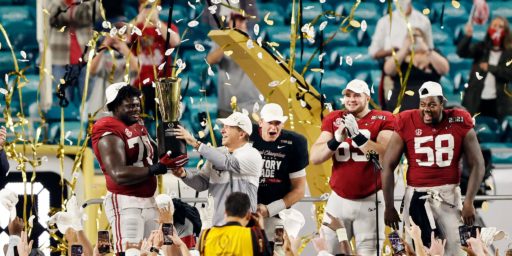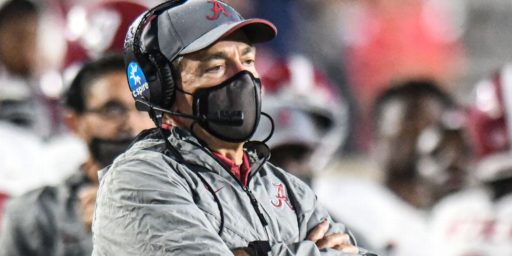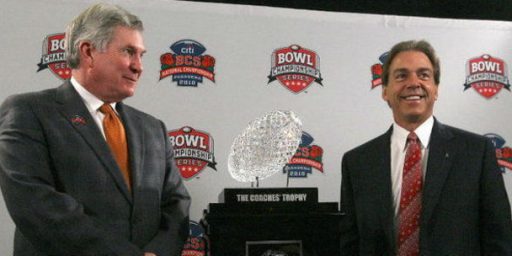Nick Saban’s Salary
My latest for TCS Daily, “Crimson with Envy: Why Nick Saban Makes More Than Your Kid’s Teacher,” is posted. It was sparked by the USA Today headline “Alabama: 45th in helping kids, No. 1 in paying coach” and other criticisms of the eight year, $32 million salary my alma mater paid to lure Saban away from the NFL’s Miami Dolphins.
While the juxtaposition of low performance in education with enormous spending on athletics at institutions of higher learning makes for great headlines, it is a ridiculous apples to oranges comparison. The money comes from different sources, based on entirely different market forces that are hardly zero sum.
Saban’s salary simply has no bearing whatever on what college presidents or CEOs are paid, much less how education is funded. His paycheck will come entirely from the University’s $68.6 million athletic budget, which is derived from ticket sales and licensing agreements rather than taxes.
If Saban is able to return the Crimson Tide to its former glory, he’ll more than pay for himself. Between July 1, 2005, and June 30, 2006, the football team alone brought in more than $44 million. Indeed, football at successful programs like Alabama’s not only pays for itself, it helps pay for all the other sports programs on campus and pours millions into the school’s academic scholarship funds.
More at the link.






College athletics are to education as jetliners are to skyscrapers…lets look at associated costs and player grades…how many pig ignorant ex-players does the world need?
People may be willing to pay more for entertainment than for education, but sometimes people are stupid.
matt: As the article notes, college football is a money maker, not a “cost,” at the elite level. And your view is that those who now play big time college football would be better educated were it not for college football?
legion: People are willing to pay and do pay more for education than for entertainment. It’s just that the scales are different. Tuition at Alabama is a hell of a lot more expensive than a season ticket in the stands. OTOH, class sizes are much smaller than the 90,000 or so seats at Bryant-Denny stadium and, while there are some distance learning courses via satellite, none of them register millions.
So we have established that there is no real link between college athletics and a college’s role in educating. Now let’s break the two completely apart and make the athletic departments simply a farm league for football and basketball players. Pay the kids and don’t make them attend class.
The colleges and universities should decide what business they are in, educating or athletic circuses.
Steven: Not sure why they can’t be both. Indeed, high schools have sports teams which, in some places at least, generic frenetic fan interest, too.
Further, aside from football and men’s basketball at big time programs, college sports are not a money maker but part of institutional spirit and otherwise serve the same purposes as at the high school level. The golf, tennis, crew, rifle, badminton, soccer and gymnastics teams aren’t bringing in the dough, generally speaking.
The state of Alabama receives many more federal tax funds than it pays into the system. If boosters and fans are rich enough to support fat salaries and big programs, maybe their share should be cut.
Christopher: As noted in the article and even the excerpt, Alabama football brings in $44 million a year. Most of that is coming from national television contracts and sponsorship deals. Paying Saban $4 mil is an investment in ensuring that revenue stream continues to grow.
If you can go back and find the 60 Minutes where the interviewed Charlie Weis. At one point they asked the University President how much they paid Weis, he didn’t answer, but responded by saying the Football teams pays the entire atheletic budget for the University and funds more 2000 academic scholarships (for non-atheletes).
I enjoyed the article and found a good perspective quite different from my own. I still, however, see the bottom line this way…
This is a taxpayer, public institution that is being misused, no matter what the source of the salary.
…..and it is the mentality behind it that keeps the deep south perpetually in the hole when it scomes to education.
Steve: But they’re paying coaches big time money in California, Michigan, Indiana, and elsewhere too. It’s a national economy for coaches and it’s hardly just the South competing.
I don’t know what UAs last coach made, but for arguement say he made $2 million a year. if the increase of yearly revenes from football is greater that $2 million, Saban was a good investment for the university becuase it means more money to support other studen atheletics and even acadamic ventures.
I’m in full agreement with Steven on this one. I’m sure a big-name athletic program brings in big bucks, but I’m leery of how much of a benefit that money is to the university & its purpose of educating people vs. supporting & improving athletics… From basic human nature, the sheer amount of money involved tends to make people (both in & out of the school) feel that the university is there to support the program, rather than the other way around…
Heck, Cal Tech just won their first basketball game since ’95 the other day, and I don’t think anyone would accuse them of being a second-rate school… 🙂
Correct about Cal, USC and the Big Ten, etc…I am coming at it as a guy who raised in the deep south. I cant really address the mentality behind the folks out west. I have only visited there briefly.
At any rate, i do appreciate the different perspective.
Alabama receives more Federal mainly because because of the large number of defense projects in Huntsville at Redstone Arsenal and the NASA space center in Huntsville. The federal payroll in Huntsville is like the 4th largest in the nation. The Air Force war college is in Montgomery too.
And some actor/actress make that much easy besides basketball players, etc. If some fat cats wanna pay a coach tons of bucks, more power to them. Whats the diff, it’a all entertainment and nobody is making football players play at college.
From a dorky accountant’s perspective (cuz I’m that, too), it pisses me off that this income isn’t taxable. For virtually any other similarly situated not-for-profit, revenue so unconnected from the org’s legit purpose would be taxable unrelated business income (UBIT). This is a sweetheart deal, plain and simple.
Yes, this is a sad commentary on the state of the nation. All hail the almighty dollar! Don’t get me wrong–I’m far from a socialist. But what is Nick Saban, the despicable liar, really worth? He didn’t win at MIami. I would have been a teacher myself, but their compensation was so poor that, given my intelliegence, I thought I could do something else more lucrative and still do good for society. So I’m a doctor. Slowly, we are being devalued as well. By the time I need a doctor myself, all the smartest young people will no longer be pursuing medicine–they’ll be CEO’s. Sad!
Nancy:
So, it’s your theory that, rather than going to medical school, they’ll just become CEOs? How does that work, exactly?